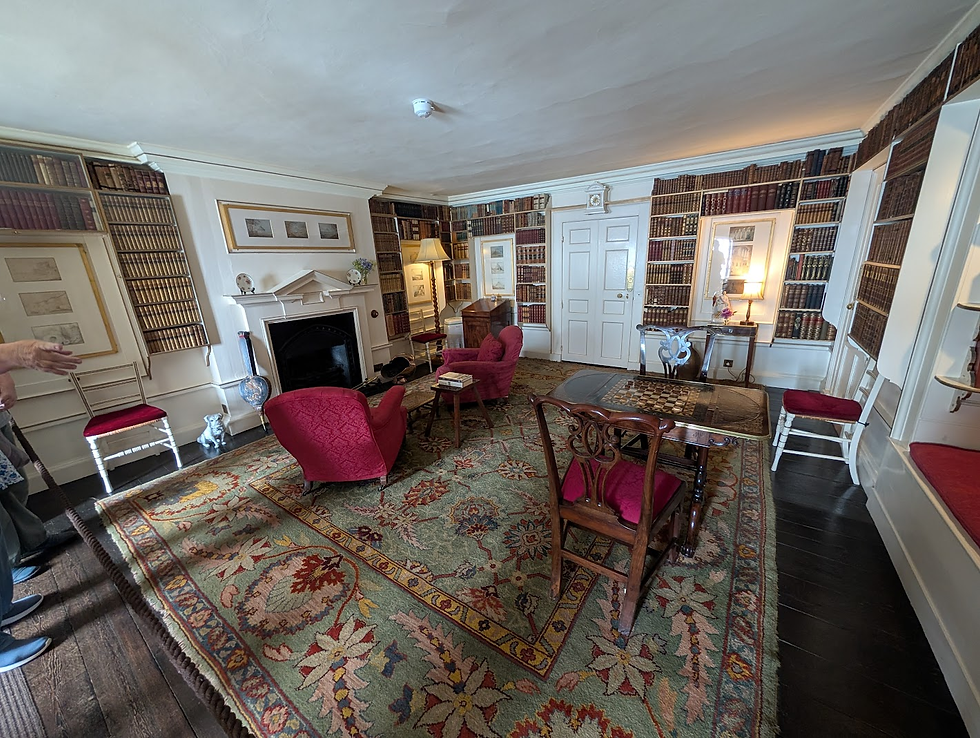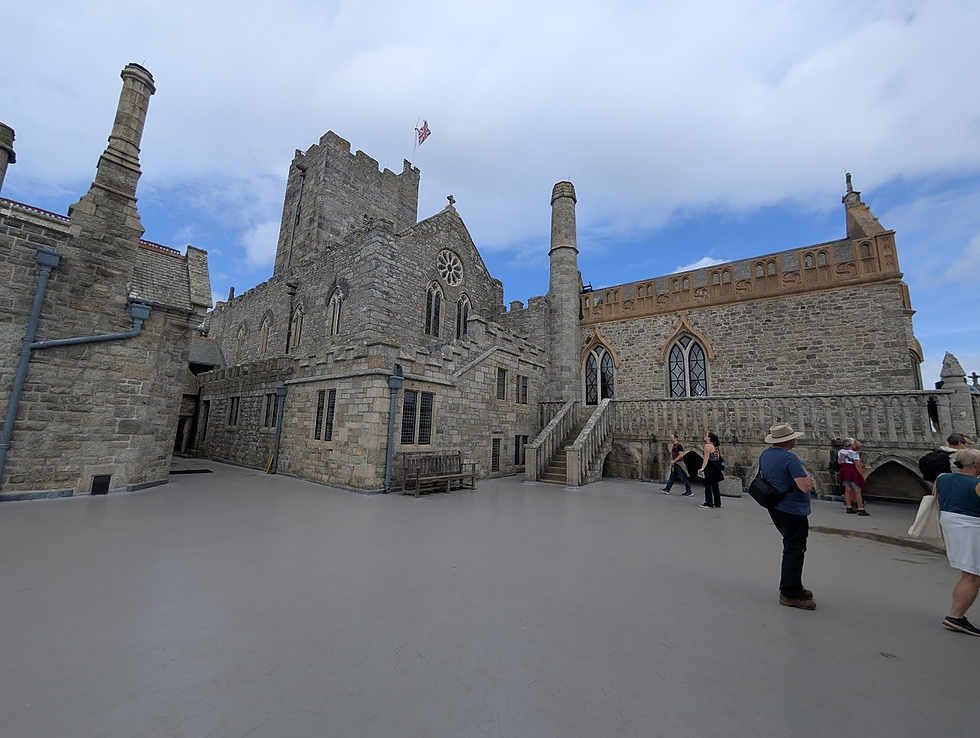St. Michael's Mount
- chirp54
- Jul 26
- 4 min read
It was another day of cobblestones as we visited St. Michael's Mount which I've wanted to visit ever since I saw a program about it on PBS. St. Michael's is a tidal island, meaning that access to it depends upon the tide. When the tide is out, there's a stone causeway that pedestrians can take to reach the island. When the tide is in, it can only be accessed by boat. We made it to the island at low tide.

The rocks are somewhat uneven, so care is needed in crossing to the island. Once there, you have a rather long climb to look forward to on the way to the castle.

I found this rather amusing:
The first part of the journey is pretty straightforward, up the Pilgrims' Steps.

Then the cobbles take over. These are not your basic city cobblestones. They're small rocks cemented into place and are, in my opinion, somewhat hellish to walk on. At one point, a sign invites you to find the Giant's heart in the pavement.
On we walked through the stunning scenery

until the hellish cobblestones ran out and we made our way up the rocks. They don't make it easy to get to the top!

At last the castle was in sight.

St. Michael's Mount is the sister of Mont-Saint-Michel in France, which is a similar tidal island, but much bigger. It may have been the site of a monastery from the 8th to the early 11th centuries. Edward the Confessor gave the island to the Benedictine monks of Mont-Saint-Michel and it was a priory of that abbey until the dissolution of the alien houses (French churches based in countries other than France.) It was a destination for pilgrims whose devotions were encouraged by an indulgence granted by Pope Gregory VII in the 11th century. The earliest buildings on the summit, including a castle, date to the 12th century. Various kings took possession of the mount from the 12th century to the 17th century. The Mount was sold in 1659 to Colonel John St. Aubyn. As of 2024, his descendants, the Lords St. Levan still live at St Michael's Mount.
We toured St. John's room with its wonderful carved fireplace,

the rather contemporary library

and a room called the Chevy Chase room, with its wonderful plaster work


and windows that date from the 15th century,

Then it was on to the church. The Church of St. Michael's and All Angels is on the footprint of the church built here in 1135, though the church as it stands now was largely rebuilt in the late-14th century. The plinth that the statue of St. Michael sits on is believed to be from the original 12th century church,

It is said that this statue of St. Michael slaying Lucifer is placed here at St. Michael's Mount because this is where it happened. As our guide said, most St. Michael's churches make the same claim.
Also in the church is a wonderful piece of stonework which is believed to be a sort of sign post for pilgrims, directing them along the route to the mount.

Most of the stained glass windows are from the 15th to 17th centuries

with the exception of the window near the organ which dates to 1910.

The organ was built in 1786 for Colonel John Lemon's London house. Legend has it that he was an insomniac and would play the organ at all hours to find relief, but the complaints of his neighbors led him to sell it to his friend, John St Aubyn. Our guide said that it was moved here and there was "quite a bit of faff getting it up here." The church still holds services on Sundays. I would love to attend, if only to hear this magnificent organ. At the opposite end of the church is the rather humble altar.

On the very large terrace outside the church

we got a marvelous view of the causeway and the town of Marazion.

From there we went to the blue drawing room

where a gentleman with the gift of gab and an obvious love of an audience held forth, telling the story of Sir John, the 5th Baronet St. Aubyn. He inherited his title and its attendant responsibilities at the tender age of 14. He undertook an extended grand tour of Europe where he developed his interests in science and the arts and, according to the guide, an appreciation of women, that is to say, sex. He eventually came home but had a bit of a problem with the notion of "settling down." He had 13 illegitimate children by two women but finally married one of them, much to the consternation of the nobility. She was the daughter of a blacksmith and not deemed "of the right class" for marriage to Sir John. The marriage, sadly, didn't change the fact that all his children were illegitimate, so none could inherit when he died. The guide told us that Sir John was the model for the character of Ross Poldark, of television and movie fame, though my research leads me to believe that that is apocryphal.
The oddest little thing on display was the model of St. Michael's Mount carved out of wine corks by a former butler. Must have had a lot of time on his hands.

We made our way down the boulders and cobble again and rounded the castle to the entrance of the garden.

Because there is rock all around the castle which casts reflected heat toward the garden, there are palm trees amongst the perennial plants.






As we headed back toward the causeway we passed a WWII era pillbox.
From there it was back across the cobblestones of the causeway and through the beautiful Cornwall scenery back to Falmouth.
















Comments